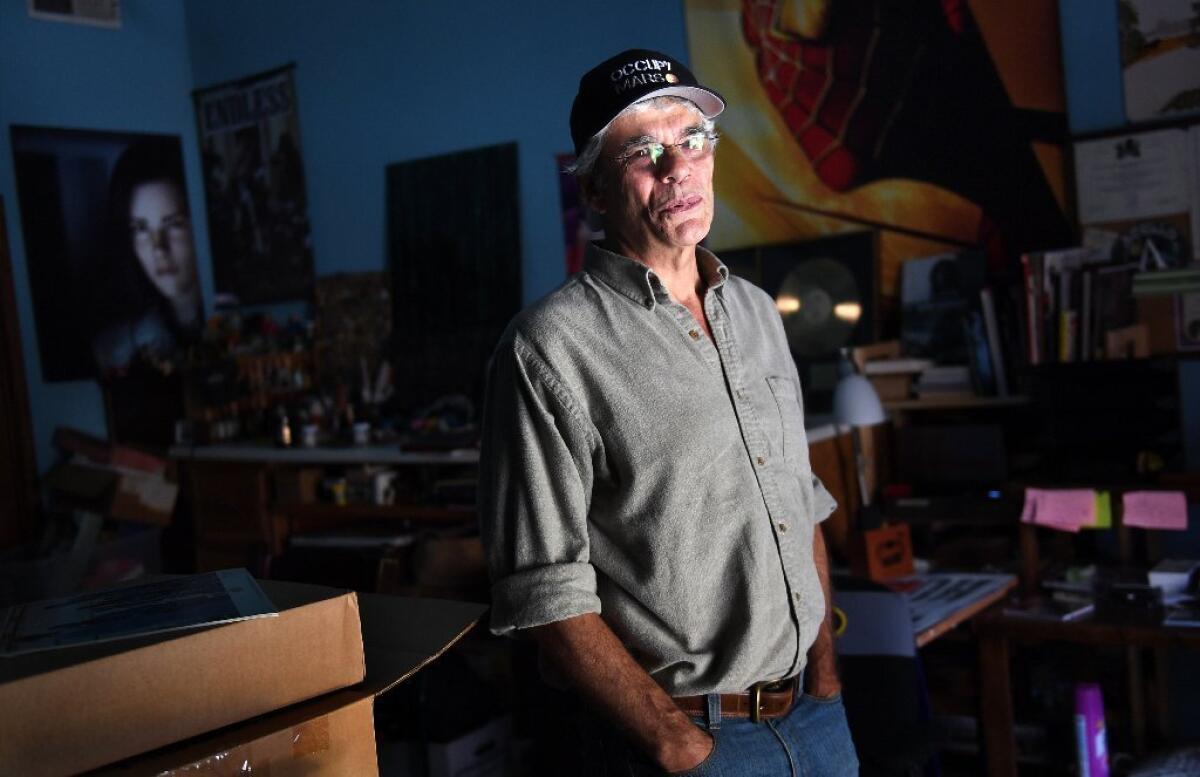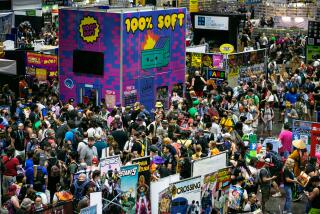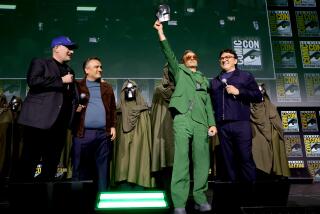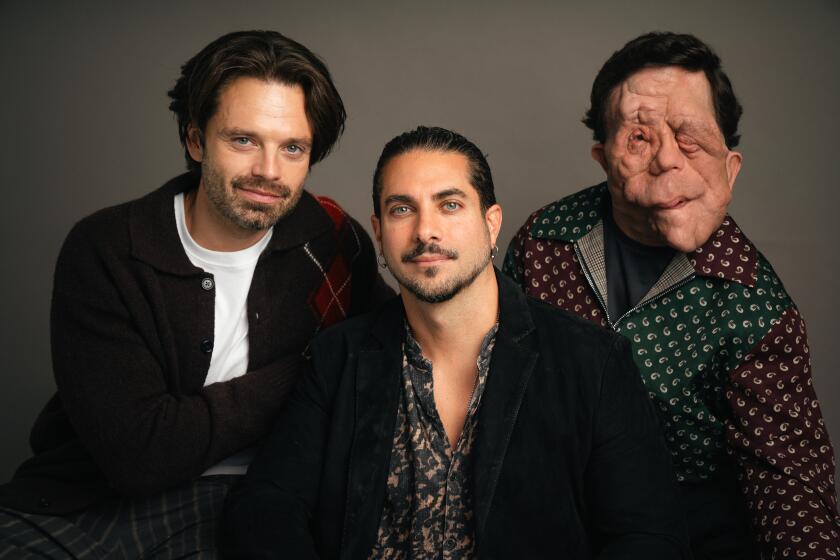Blame those endless Hall H lines on Jeff Walker, the man who brought Hollywood to Comic-Con

In a galaxy known as New York, in a drab age before Trekkies and light sabers, there lived a curious boy who liked comic books, time travel and Elvis. He read Isaac Asimov and tuned in to John Zacherle, this Phantom of the Opera-type guy with scraggly hair and a creepy laugh who introduced horror movies on Channel 9, which, if you were a kid at the time, was something close to splendid.
This boy, let’s call him Jeffrey Walker, who incidentally would later watch “2001: A Space Odyssey” 29 times, tended toward the imaginative. His mother was a beauty queen, his father a clothier. Walker grew up to be many things, including an actor who played poker with Jesus Christ, shot a nude scene with Al Pacino and was hugged by Natalie Wood. This is not that Walker story.
This tale is about the man who helped transform Comic-Con into the pop-culture bazaar it is today by bridging the gap between Hollywood and the world of science fiction and comic book fandom. He was not alone, but Walker’s understanding of genre, marketing, music and film brought the movie business — and the likes of Arnold Schwarzenegger and Christian Bale — to the loyal and lucrative fantasy domains of nerds, geeks and all those who costume out as droids, Stormtroopers, aliens, hobbits, Jokers, Supergirls, Captain Americas and steampunks.
“Comic-Con was the perfect convention to grow like it did,” said Walker, a publicist and media consultant who lives and works in a rambling house and office in Laurel Canyon. “It had location. It had pros in the business fans wanted to meet. … It was the biggest tent in terms of fandom.”
Some, though, believe the mating of these two worlds has created a beast much too beholden to the Hollywood bottom line.
“Jeff brought movies to Comic-Con to fit comic book tastes,” said Len Wein, a comic book writer and editor known for creating Marvel’s Wolverine and DC Comics’ Swamp Thing and editing DC’s seminal series “Watchmen.” “But now [the convention is] this science-fiction fantasy show that acknowledges comic books. That’s because of Hollywood studio money and power. I think there’s friction here and there between the studios and the cons.” He added, “I call Comic-Con the Bataan death march with Wookiees.”
I call Comic-Con the Bataan death march with Wookiees.
— Len Wein, comic book writer and editor
More than 130,000 fans are expected to attend this week’s convention, a universe vastly different than it was in 1970 when Shel Dorf, Ken Krueger, Richard Alf and others gathered in a hotel basement for what was called San Diego’s Golden State Comic-Con. Since showing “Star Wars” slides on a wall, Comic-Con has welcomed Tim Burton’s “Batman”; the growth of the Internet; the “Twilight” franchise, which brought more women into Comic-Con; global fervor for the video game industry; a television renaissance that delivered “The Walking Dead” and “Game of Thrones”; the rise of virtual reality; and a new wave of independent horror and sci-fi films such as Shane Carruth’s “Primer.” As Comic-Con goes, so goes entertainment.
Not always. When Walker moved to Los Angeles in 1968 to be an actor, the founding of Comic-Con, which opens Wednesday at the San Diego Convention Center, was still two years away. He landed bit parts in “Panic in Needle Park” and “Bob & Carol & Ted & Alice.” A man who loved Edgar Allan Poe as much as reggae, Walker started writing music reviews for $35 a pop at publications like Phonograph Record Magazine and Cashbox. He was editor of Music World, where he met rising talents like Cameron Crowe, who wrote for him before moving on to Rolling Stone.
By the early 1970s young filmmakers such as Steven Spielberg and George Lucas — who were shaped in an era of cheesy ray-gun space movies, threats of the atomic annihilation, the Beatles, Rod Serling and Ray Bradbury — were trying to make sense of a world shaken by the Vietnam War and civil rights movements. Walker kept up his music reviews and later went to work for record labels, including handling national publicity for Island Records, where he learned the intricacies of different fan communities, which would lead to his marketing ventures in commingling science fiction, comics and movies.
He traveled to conventions around the country and met Charles Lippincott, a publicist for Alfred Hitchcock who worked for Lucas in 1976. “He was my mentor,” Walker said of Lippincott. “He was the first person to show ‘Star Wars’ slides at conventions. That was the beginning.”
Walker, who would later market films for Warner Bros. and Spielberg’s Amblin Entertainment, including “Gremlins” and “Back to the Future II,” advanced Lippincott’s strategy by bringing to conventions movie trailers and 16-millimeter featurettes to give fans behind-the-scenes glimpses of films such as “Outland” and “Blade Runner.”
The conventions in those days were populated by gaggles of mostly white guys holding boxes of comic books and speaking in nerd while pondering light years and the predilections of monsters and robots.
“Jeff is the guy who really put it together by knowing the needs of the magazines and knowing the conventions,” said David McDonnell, editor of the now-defunct science fiction magazine Starlog, founded in 1976 to capitalize on the flowering “Star Trek” fandom. “He was well connected in the movie industry. He brought Tom Cruise to the Denver science fiction convention to promote ‘Interview With a Vampire.’ He brought Francis Ford Coppola to a convention for ‘Bram Stoker’s Dracula.’ This electrified audiences.”
Walker also co-founded the Thinking Cap Co., which had licensing rights to create replicas of caps and insignias for “Alien,” “The Empire Strikes Back” and many other movies.
“Comic-Con embraced it all,” he said. “You could see the growth of geek culture. It was obvious.” He added that today’s science fiction and comic book fans have a respect for “the fathers of the genre that you don’t see in other areas except rock ‘n’ roll. These are the groups that imagine things and make them real.”
His hair gray and his manner soft, Walker, who once introduced science fiction writer Philip K. Dick to “Blade Runner” director Ridley Scott, ambled into his office the other day. It was a small, messy kingdom, like a library out of “The League of Extraordinary Gentlemen.” Filled with statues, buttons, photographs, the room spoke to more than half-a-century’s pop culture fantasies, stretching from Bettie Page to three-headed dragons to Supergirl to an original 2002 movie poster — later re-edited — that showed the World Trade Center towers gleaming in Spider-Man’s eyes.
But like all good make-believe settings there was a flash of incongruity, a huge, gold-framed pre-Raphaelite-style pastoral painting that hung square center over it all. Walker smiled as if to suggest that a man, even a sci-fi geek, contains untold dimensions. He turned to another wall. “This is one of my favorites,” he said, pointing past a picture of Rod Serling to an old newspaper ad that read: “Civilization Inventory Clearance. Everything Must Go.”
Which brings us back, not so incongruously, to that galaxy in New York in that shudder-to-think-about-it time before special effects. Walker’s father, who had flown bombing missions over Nazi Germany, and his mother, who was Miss Illinois in 1946, heard that psychologists and the government believed comic books were bad for a child’s mind. His mother trashed his collection. But he still had TV and old films like “Abbott and Costello Meet Frankenstein.”
“That movie,” he said, “was an early meta-merging of genres.”
ALSO
‘Gods’ and ‘Squads’ will fight for the attention of the masses at San Diego Comic-Con 2016
Inside the world of fan filmmaking, where lovers of ‘Star Wars’ and ‘Star Trek’ play
The must see panels at 2016 San Diego Comic-Con
More to Read
Only good movies
Get the Indie Focus newsletter, Mark Olsen's weekly guide to the world of cinema.
You may occasionally receive promotional content from the Los Angeles Times.











